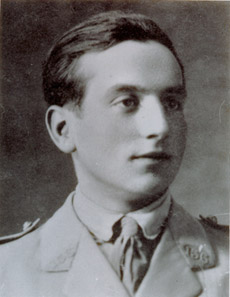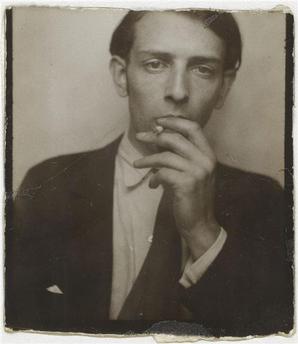<Back to Index>
- Poet Joë Bousquet, 1897
- Photographer Jacques - André Boiffard, 1902
PAGE SPONSOR

Joë Bousquet (Narbonne, March 19, 1897 - Carcassonne, September 28, 1950) was a French poet.
Wounded on May 27, 1918 at Vailly, near the Aisne battlelines, at the end of the First World War, he was paralyzed for the rest of his life, and lived a life largely bedridden, surrounded by his books. His physical incapacity and constant pain (for which he took opium) caused a retreat from the world, but also became the starting point for an extensive body of poetry and writing. He contributed poetry to the Carcassonne poetic review Cahiers du Sud, and carried on a correspondence with many writers and friends, including Louis Aragon, André Gide, Paul Éluard, Max Ernst and Simone Weil. His home in Carcassonne, France, is now a museum in his memory.
Bousquet became friends with the surrealists, and his poetry is often associated with them. He also purchased paintings by Salvador Dalí, Max Ernst, Jean Fautrier, Wols, André Masson and Hans Bellmer, and was modeled by René Iché and painted by Jean Dubuffet.
His work was admired by many famous French writers of the
20th century, including René Char, Louis Aragon, André
Breton, Gide, Valéry, and, most notably, Gilles Deleuze.

Jacques-André Boiffard (1902 - 1961) is a French photographer, born in Paris, lived in Roche - sur - Yon. He was a medical student until 1924 when he met André Breton through Pierre Naville, a Surrealist writer, and childhood friend.
In the mid 1920s, Boiffard decided to dedicate himself to research in the Bureau of Surrealist Research, writing the preface with Paul Éluard and Roger Vitrac to the first issue of La Révolution surréaliste. Preferring photography to literature, he became Man Ray’s assistant. During the 1920s, he took portraits of the English writer Nancy Cunard and photographs of Paris which Breton used to illustrate his novel Nadja. In 1928, Boiffard was abruptly expelled from the movement for taking photographs of Simone Breton.
From 1929, Boiffard was closely associated with Georges Bataille and Documents, in which his best known work was published, illustrating articles such as Bataille’s "The Big Toe" (1929, issue 6), Robert Desnos’ "Pygmalion and the Sphinx" (1930, issue 1), and Georges Limbour’s "Eschyle, the carnival and the civilized" (1930, issue 2). In 1930, he contributed to Un Cadavre, a pamphlet that attacked Breton.
Boiffard then set out on a world tour with fellow photographer Eli Lotar. Although partly financed by museologist Georges Henri Rivière and the Vicomte de Noailles, the trip came to an early end in Tangiers. During the political turmoil of the 1930s, Boiffard was a member of the Groupe Octobre led by Jacques Prévert, and he exhibited his work as part of the Association des Écrivains et Artistes Révolutionnaires.
Following his father's death in 1935, Boiffard resumed his studies to earn a doctorate in medicine in 1940 specializing in radiology, once and for all putting an end to his career as a photographer.